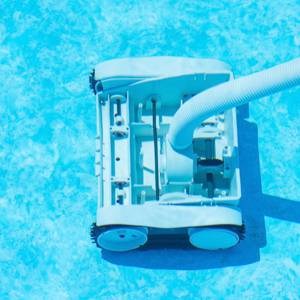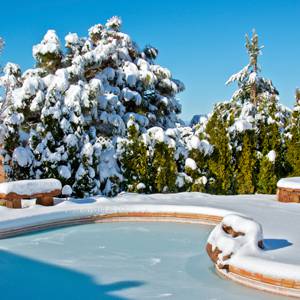Pool maintenance can be a headache through the fall and winter. Stay on top with this checklist.
For the majority of pool owners, they'd like their pool to operate year round. Closing or shutting down the pool is only recommended when there is ongoing maintenance and if it is too much for the homeowner to handle.

During fall and winter months, it is essential to winterize your pool for the main purpose of protecting it from damage due to freezing water. Another thing is to keep it as clean as possible when warm weather returns in the spring. Here is a step-by-step process for cost-effective and headache-free swimming pool maintenance over the cold season.
1. Balance the water
 It is important to bring back balance to your pool water during its maintenance period. Pool pH should between 7.6 and 7.8, while pool alkalinity should be from 80 to 100, and its calcium hardness should be between 150 and 250. Before adding any pool algaecides or any pool winterizing chemicals, make sure the pool chlorine has already come down to 1.5-3.5 ppm (normal level).
It is important to bring back balance to your pool water during its maintenance period. Pool pH should between 7.6 and 7.8, while pool alkalinity should be from 80 to 100, and its calcium hardness should be between 150 and 250. Before adding any pool algaecides or any pool winterizing chemicals, make sure the pool chlorine has already come down to 1.5-3.5 ppm (normal level).
2. Lower the water level
Lower the water level to about 4”-6” below the lowest plumbing line using either a filter pump or a submersible pump. Be sure the water level is at its return line or below the skimmer.
3. Empty your chemical feeder
 Drain and empty your chemical feeder during your pre-fall/winter maintenance and pool winterization efforts to prevent any equipment damage. Do not leave the top of the chemical feeder unopened but make sure to wear safety goggles and gloves when you put it back.
Drain and empty your chemical feeder during your pre-fall/winter maintenance and pool winterization efforts to prevent any equipment damage. Do not leave the top of the chemical feeder unopened but make sure to wear safety goggles and gloves when you put it back.
4. Make sure algae formation has not occurred
Water temperature that is less than 60 degrees is not an ideal breeding ground for algae. However, you should still check your pool water to ensure algae won’t be able to survive and thrive here. Prevent extended periods of algae growth by adding shock treatment or algaecide to your pool water. This will help save your pool’s liner, concrete and other areas. Plus, it would be ready to be used when summer time arrives.
5. Remove all in-ground and above ground pool accessories
 Remove everything that should not be in the pool including handrails, ladders, slide, heaters, skimmer baskets, wall fittings and vacuums. Remove all debris from the bottom or on the top of your pool using a leaf rake. Keep your pool water chemistry on track by investing in a winterization swimming pool water treatment kit. It is readily available at your local pool professional retailer.
Remove everything that should not be in the pool including handrails, ladders, slide, heaters, skimmer baskets, wall fittings and vacuums. Remove all debris from the bottom or on the top of your pool using a leaf rake. Keep your pool water chemistry on track by investing in a winterization swimming pool water treatment kit. It is readily available at your local pool professional retailer.
6. Scoop out any debris from the top of your pool cover
This will minimize the possibility of having your pool cover ripped, torn or damaged during fall and winter months. If you are using leaf nets, dispose it as soon as it has accumulated on top of the net. Use a solid pool cover that keeps out all debris and sun.
7. Secure your pool cover
If your pool is above ground, make sure of the following:
- the heavy-duty air pillow is inflated and holding up your cover
- cover clips or winter seal wrap is secure
- cover cable is tightened
- the winter cover wall bags or blocks are holding your pool cover in place
If your pool is in-ground, make sure of the following:
- the winter cover wall bags or blocks are holding your pool cover in place
- the patio/deck area is protected by various safety cover components
8. Keep your pool water circulating on a regular basis
Run your pool pump for a few hours every other day over the fall and winter months will keep it free from bacteria, mosquitoes and other harmful occurrences that may exist when pool water is left stagnant. Ideally, you should run it for at least 4 hours during long periods of nonuse.












Write a Comment